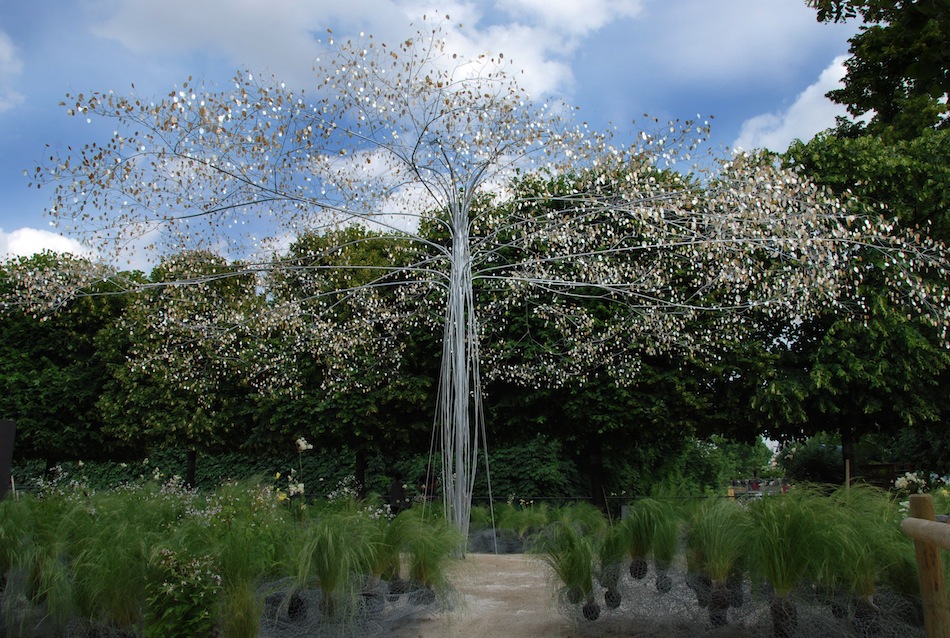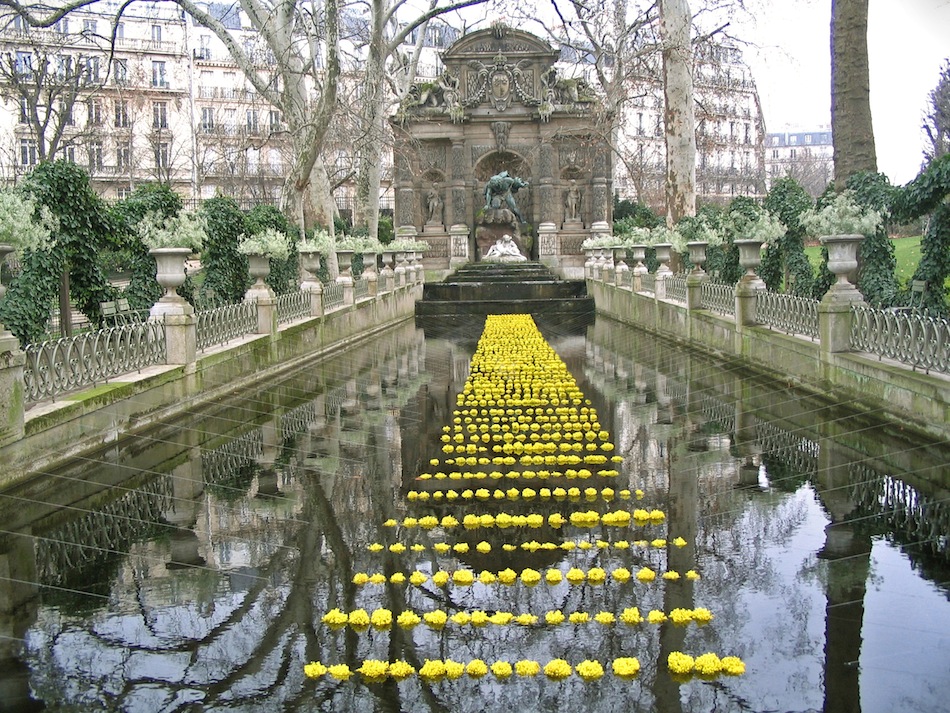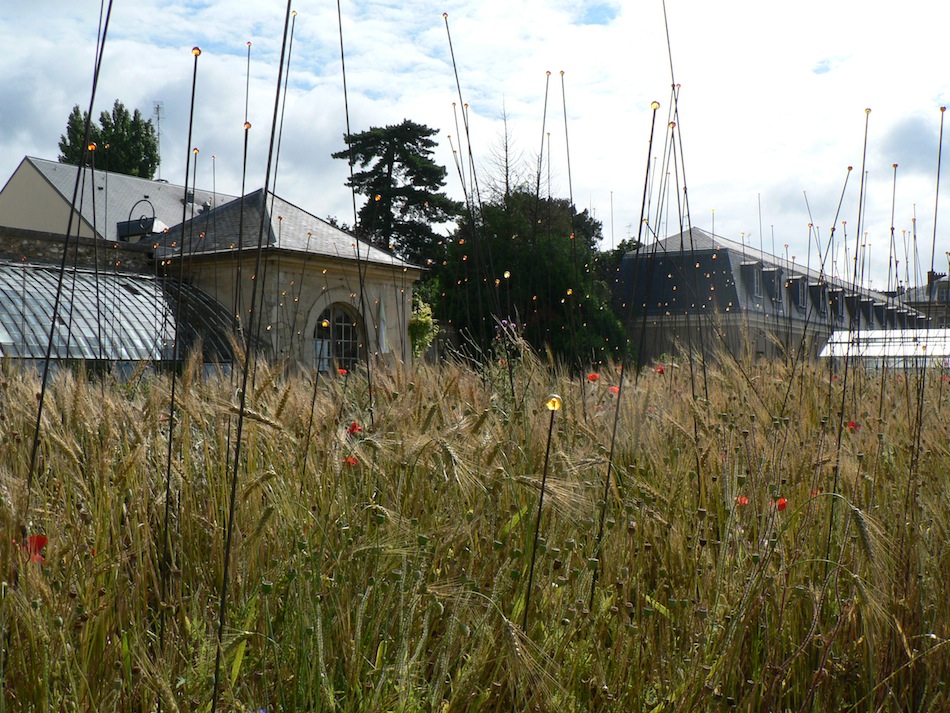Interview: cao | perrot Studio
EMERGING VOICE 2013
cao | perrot Studio
cao | perrot Studio, led by Andy Cao from Los Angeles and Xavier Perrot from Paris, blends art and landscape to create “hybrid environments.” Often drawing on themes of diaspora, imagination, and memory, the studio’s work, what it calls “incidental placemaking,” weaves personal narratives into fanciful yet mindful sites that fuse dreams and reality. The office works in commercial, artistic, and residential settings and has recently completed: the Guangming Central Park in Shenzen, China; the Red Bowl installation at Maladrerie Saint-Lazare in Beauvais, France; and Jardin des Hespérides in Métis-sur-Mer, Quebec. On the occasion of their lecture (video below), Cao and Perrot sat down with League Program Associate Ian Veidenheimer to discuss their practice.
Ian Veidenheimer: This prize series specifically emphasizes voice. How would you describe your voice?
Andy Cao: I would say we don’t have a specific voice or signature. It is always changing. We gravitate to things we experience or observe in our surroundings, so everywhere we go influences the next project. We are drawn to beautiful, well-made things that are not necessarily perfect, but which we can appreciate for the effort that went into making them. We also focus on serendipity and the incidental: things that are just there that make you slow down and see how they affect you. One constant is that we want to see how fully we can cultivate a dream world that people can step into.
Xavier Perrot: When you create a dream, not everything has to make sense. The connections and links between the things that compose the dream are not always clear.
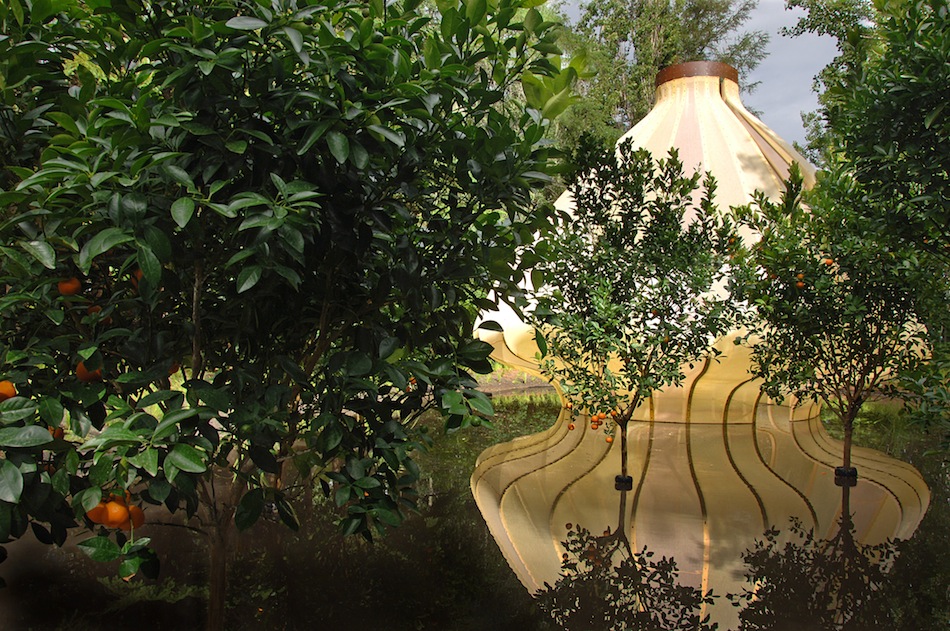
Jardin des Hespérides, Metis International Gardens Festival, Quebec | Photo by Louise Tanguay
Veidenheimer: You use two terms to describe your work: hybrid environments and incidental placemaking. What do these mean to you and how do you achieve them?
Cao: Early on, we were attracted to fashion and art—we looked at these fields and saw people having fun at a time when we felt limited to using planting palettes and conventional building materials. We wanted to bridge the gap between landscape and art. When you start removing or abstracting the functional aspect of a landscape so it also works as an artistic space, it becomes a hybrid environment.
Our conception of incidental placemaking came out of observing how different environments are created. On one wonderful trip to India, we spent time in Dharavi, a slum in Mumbai, which is such a strange, surreal, atmospheric, beautiful place. Everywhere we looked we saw inspiration in the most mundane things. And these were organic results of a million people living together. You cannot design that; in some way it just happens. It is the same effect when you see trees growing up the wall of a neglected building; it’s so haunting, yet so beautiful. We really like that feeling, and it’s very hard to make something look effortless and just there. Seeking this effect is what links many of our projects and, for lack of a better word, we call it incidental placemaking. Everything is deliberate, but the results look simple or effortless. It’s like a dream: you can’t describe or explain it, you just have to experience it. We’re very interested in this kind of totally immersive environment.
Veidenheimer: Symbolism is often present in the immersive environments that you create. Do you begin your projects with this interest or is your work more rooted in the site you are working with?
Cao: This question gets at a distinction that’s always interested me: what is the difference between a landscape architect’s work and a landscape created by an artist? If you are a landscape architect, when you create something there’s a tendency to explain what represents what, because there’s always logic or purpose behind it. If you look at Robert Irwin’s work from a strictly landscape architecture point of view it’s not special, but if you look carefully, you see a work of art that uses landscape as its medium. We’re constantly being told that our work is not landscape architecture, that we just create environments. I wish we could be considered both landscape architects and landscape artists, but apparently you can’t be both. We think it’s more appealing and flexible to be a landscape artist, but it gets confusing, especially in the public art realm, to come from landscape architecture and say that what we create is art. When you blur that line you erase the norm. So, we have a hard time defining what we do. I say, don’t label it; just focus on the experience.
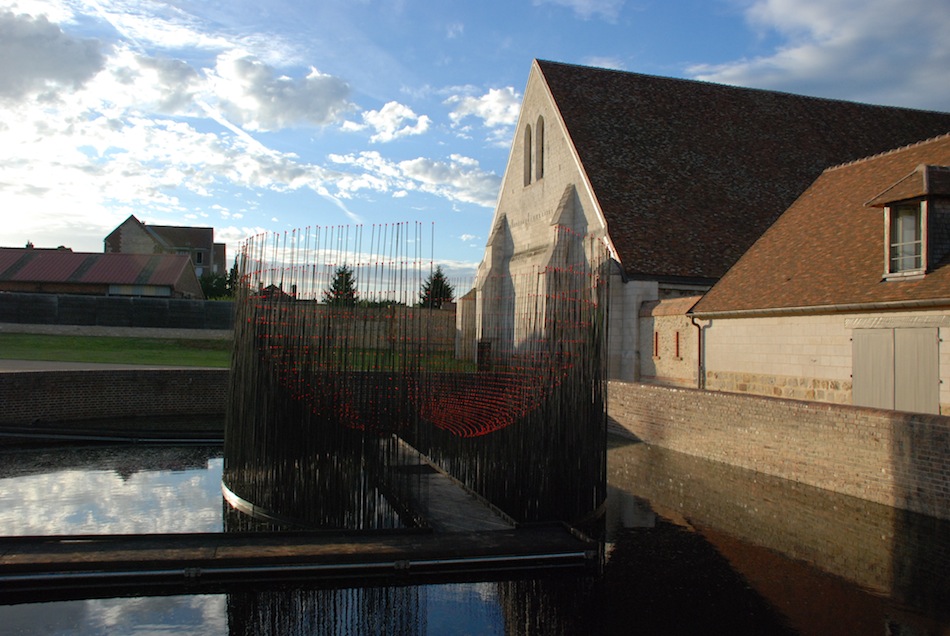
Red Bowl, Maladrerie Saint-Lazare, Beauvais (France) | Photo courtesy of cao | perrot Studio
Veidenheimer: Are the natural elements in your work chosen purely for effect, or do they serve greater ecological or infrastructural functions? I’m thinking specifically of your Red Bowl project where you selected duckweed to create a “soft, green, proliferating surface,” that spread throughout the pond.
Perrot: Those functions are not a necessarily our priority. Plants are more of an artistic medium than anything else. The duckweed was used for two purposes: an aesthetic purpose, because it proliferates on the surface of the water, and a symbolic one. In that project we were trying to understand and transpose the way of life of people in medieval times to the modern day. The duckweed had the same spreading capacity that disease had at that time, and it rested on the water’s surface. The water is pitch black and you don’t know how deep it is, so you want to keep your distance. In addition to the aesthetic, we wanted the duckweed and water to have that psychological impact.
Cao: It’s difficult to explain why we’re drawn to certain mediums or materials, but budget is always a factor. We often start with materials that are ready-made or available at the hardware store. We think of materials that move us when used in other disciplines, and then change their application and association for the medium of landscape. For example, we know that chicken wire is useful, but when you start folding and sculpting it, it also becomes a fabric with a gossamer effect.
Veidenheimer: How do the artificial and the natural interact in your material selection and your choice of landscape elements?
Perrot: We don’t intentionally deal with this distinction. We like materials that will somehow evolve or react to natural conditions. It doesn’t matter if those are natural or artificial as long as the materials transform the environment.
Cao: We are often drawn to opposing extremes. If we work with glass or fishing line, materials with a reflective quality, in the next project we might work with material that’s very opaque, maybe stone or wood, to see what the opposite does.
We don’t try to imitate nature, but we get a whole new appreciation of it when we try to make a cloud or a tree, these everyday things you see but don’t question. It’s impossible to draw a cloud that we will integrate into a design, because we don’t know what shape it will take until it slowly unfolds as we make it. We’re drawn to that unknown and in a way that frees us. We let intuition and emotion guide our hands. The clouds we made reflected our state of mind: if we are tense, the clouds become dense; if we’re relaxed, they become fluid and billowy. Suddenly you have all these personalities, and you have to combine them into oneexpression.
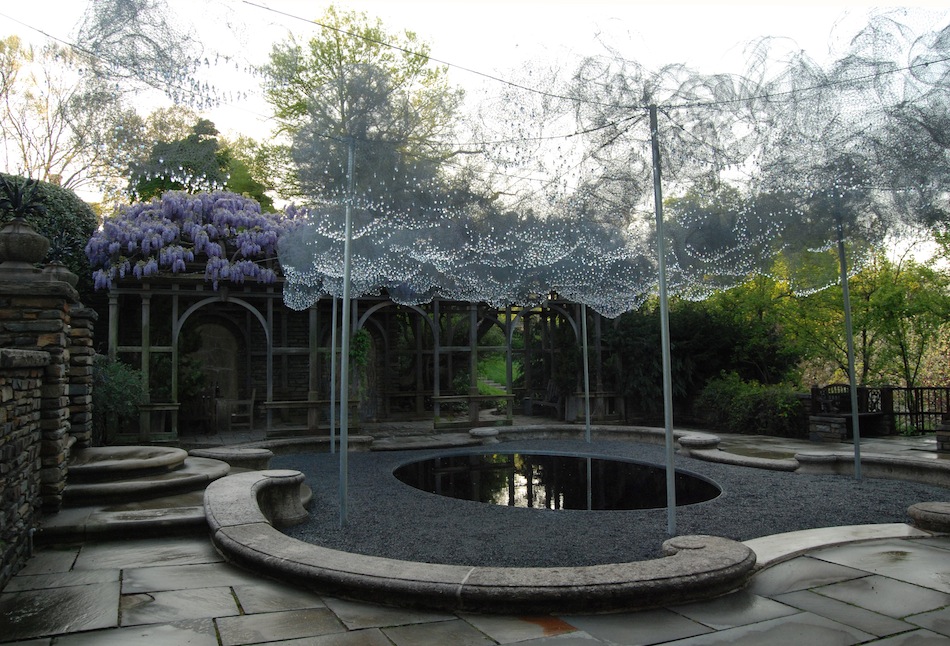
Cloud Terrace, Dumbarton Oaks, Washington, D.C. | Photo by Stephen Jerrome
Perrot: You can only anticipate 80% or 90% of how the materials will react with light or wind. There’s always the unknown, cast shadows, for example, that we discover on site. Part of the beauty of the work is this touch of ephemerality, even in a permanent work. That’s what is quite appealing about the clouds and the trees we make: they look fragile, ephemeral, but they are strong. It’s especially important to play with the materials, because we often use them outside of their original contexts. You don’t make clouds with chicken wire very often. We can’t prove anything until we show that it works.
Cao: To make a tree, we started to create thousands of leaves and hung them twig by twig. I’ve never looked at a tree the same. It’s similar to a Pointillist painting, the whole image composed of tiny, infinite marks that come to life. The more we know about a material, the harder it is for us to discover something. So, we just play with it and the more we do, the more we discover. We made the leaves from mother of pearl on a hunch, partly because it was a material that was readily available. It has a reflective quality, so when the light hit the leaves, they transform into volumes of light, in that same Pointillist effect. We realized 70% of our vision, but the rest was a surprise. We didn’t anticipate that the sound of the rustling leaves would be so hypnotic. There’s something similarly arresting about walking on recycled glass, which we’ve used in a number of our projects. It’s just like treading on gems; suddenly a recycled material seems luxurious.
We looked at this glass and the chicken wire of the cloud and thought to mix them up, so we combined our clouds with Swarovski crystals in a few projects. On a cloudy day the crystals look like dew drops on a spider web, and when the sun comes up, they’re unabashedly loud. There’s so much personality in all of these materials. At the end of the day, I think the only meaning we can see in our work is in making.

Willow Tree, Grand Prairie Central Park, Texas | Photo courtesy of cao | perrot Studio | Click for a project slideshow
Veidenheimer: Do you still try to achieve these carefully created moments in your larger scale projects?
Perrot: Yes, we have the same approach. We want to create a surprising, dream-like experience to be discovered in a big area. We consider our temporary garden installations to be sketches where we can try out ideas and materials to potentially implement in larger, more permanent projects.
Cao: We propose projects, big or small, that cannot be realized unless we are involved, and whatever project we do, the only requirement is that we stay on site. You’re never going to get paid enough, but it’s hands-on so you have to be 100% involved. For the Cloud Terrace installation at Dumbarton Oaks in Washington, DC, we stayed there for a month, just like a fellowship, and we got to know Beatrix Farrand’s gardens intimately.
Veidenheimer: How does the idea of beauty affect your work? Is there room for the clunky, the ugly, and the awkward in your work?
Cao: We really love the idea of beauty. Nobody talks about it, and it’s almost a dirty word. When I saw Robert Irwin lecture, he said that at the end of the day all that matters to him is creating beauty. It could be grotesque beauty. Decay can be beautiful. There’s a reason we’re drawn to lumps and bumps in fashion. When we walk down the street, we stop when someone’s wearing something extreme, and though you might never wear it, you admire the person’s courage to express himself. We wonder if we can do the same thing in a landscape. Why must landscape and architecture flow seamlessly? Why can’t they stand side by side and have their own voice, whether clunky, refined, or outrageous? Why are there all these rules? We can go down the list of all the other important issues — sustainability, etc. — but if there’s a lack of aesthetic, then everything looks the same.
Veidenheimer: What historical precedents do you draw upon and how do you situate your work in this history of garden and landscape design?
Cao: Ours is a different approach than what has been done in the past, I suppose. When you look at Le Notre on through contemporary landscape architects, there are just so many influences that we have to remove ourselves from them to a certain extent. I really appreciate Martha Schwartz because she opened the door for landscape architects to also do public art. Whether you like her work or not, she’s had a very important impact on the profession. There’s no point in trying to be another Schwartz though. People like her are so true to their vision. We think it may be better to stay under the radar and do our own thing.
•••
Andy Cao and Xavier Perrot, cao | perrot Studio, Emerging Voices 2013, complete lecture video | Recorded March 28, 2013 | Running time: 59:11
•••
Andy Cao received a B.S. in Landscape Architecture from California State Polytechnic University, and has taught at California State Polytechnic University and the University of Southern California School of Architecture. Cao is both a Loeb Fellow and Rome Prize winner. Xavier Perrot studied landscape design at the Conservatoire International des Parcs et Jardins et du Paysage (France). Perrot received the Emerging Young Landscape designer award from the French Ministry of Culture and Communication. See more of the studio’s work at caoperrotstudio.com.


